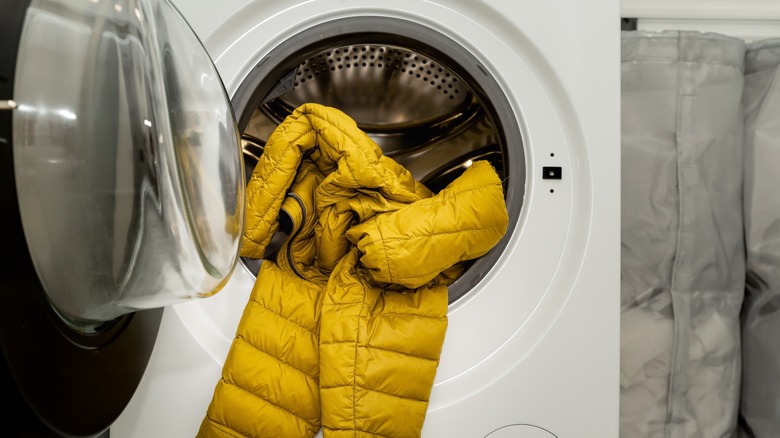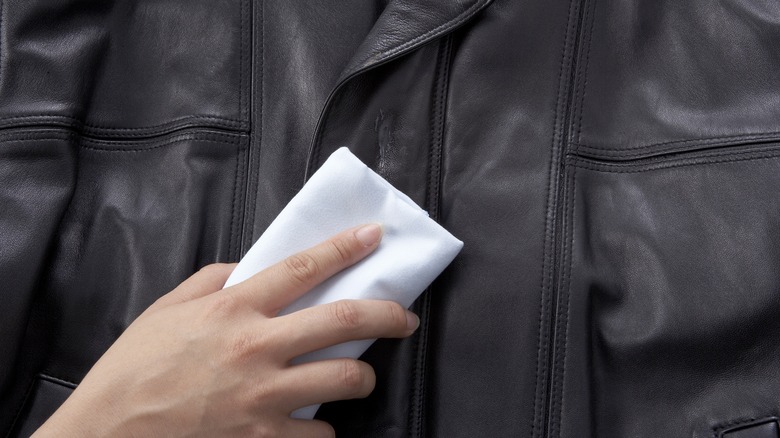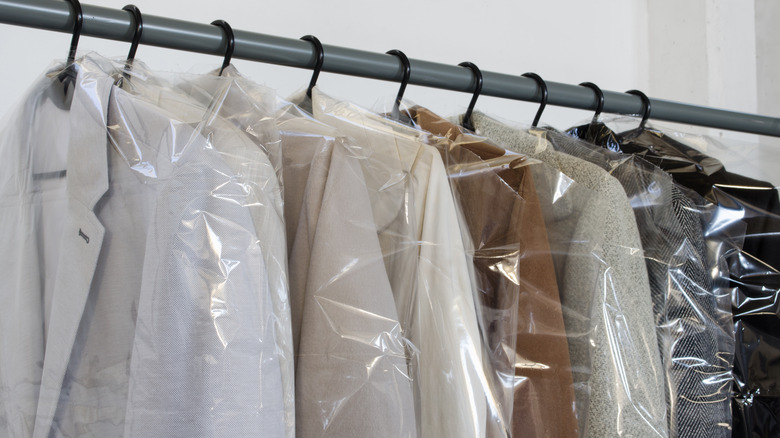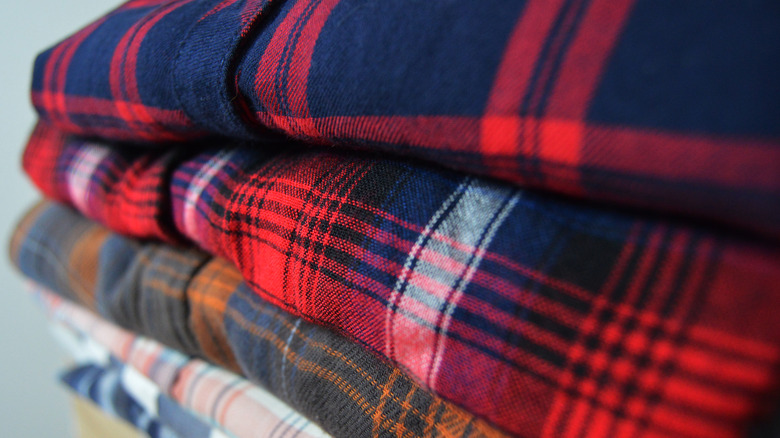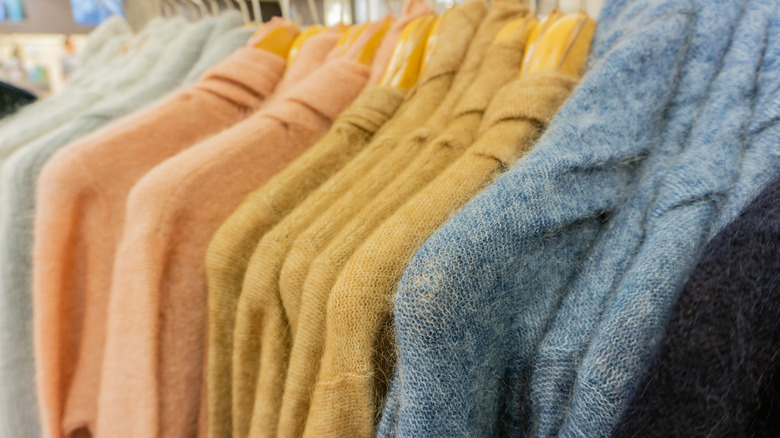The Best Way To Launder Winter Coats Of All Materials
The winter coats in your closet are likely made from various fabrics. Kelly's Dry Cleaners shares these typically include wool, flannel, faux fur, cashmere, cotton, mohair, and corduroy. Whether your favorite coats are made from one of these materials or something else, learning the best way to launder them is essential.
Checking the manufacturer's care label can often offer some guidance. However, these tags are not always the easiest to read. Some may even include symbols instead of written directions, making them even more confusing. Tide shares advice to help individuals decipher the various care and cleaning symbols commonly found on garments. For example, an open tub symbol with a wavy water line indicates that the item can be washed in a washing machine, while the same symbol with a hand over the tub tells you that the item requires hand-washing. Solid dots in the center of the washtub image let you know the recommended water temperatures. One dot means that you should use cold water, two dots mean that warm water is best, and three dots mean that hot water should be used.
According to BNK Bubbles, following the manufacturer's recommended care instructions is important to prevent your favorite coats from fading, shrinking, or getting otherwise damaged. Reading through the tips below for washing winter coats made with different materials — along with paying close attention to the recommendations offered by the manufacturer — can help you identify the best way to wash your coats.
How to launder wool coats
If you have a wool coat that got dirty or hasn't been cleaned for several months, now is the time to wash it. According to Wirecutter, keeping wool clean is essential to protect it against damage from moths, who love dirty wool even more than they love clean wool. Laundering your wool coat can also improve its appearance, helping you look sharper the next time you wear it. Before you try washing it at home, remember to check the care label. If the manufacturer doesn't specify that a professional dry cleaner should only clean the coat, you should be able to carefully clean a wool coat at home. Before washing the coat, you'll want to remove pills (small lint balls) using a fabric shaver or garment comb.
Afterward, check for stains and pre-treat them with a small amount of mild dish soap. Depending on your washing machine and its settings, you may be able to use it to launder a wool coat. Just be sure to use cold water and a delicate cycle (or a wool cycle, if your machine offers one). Always use a mild laundry detergent when washing wool garments.
The other option is to hand-wash a wool coat. Fill a large basin with lukewarm water and about ¾ teaspoon of mild detergent. Then, add the coat to the basin and let it soak for half an hour before agitating the water for a deeper clean. Rinse the coat, and remove excess water by putting it on a towel and rolling it. Lay it flat to dry, and turn it over once or twice each day until completely dry.
How to launder fleece coats
Most fleece coats can be washed in the washing machine, but you'll want to check the care label on your jacket to confirm. However, as Kelly's Dry Cleaners explains, you don't want to simply toss a fleece jacket in with any old load of laundry. Fleece is a unique material, and as such, requires special care when cleaning.
First, to minimize pilling on the fleece, turn the jacket inside out before washing it. It is also essential to use cold water and powdered detergent. Hot water may damage the fabric, while liquid detergent can negatively impact the fleece's ability to resist or repel water. Before adding the fleece coat to the washing machine, measure the powdered detergent and fill the machine with some water. Allowing the water and detergent to mix before adding the jacket will prevent detergent residue from sticking to the material.
Add any other fleece items you have to wash to fill up the load. Other lint-free items can also be washed, but you'll want to avoid adding anything that creates lint as it can damage the fabric; trying to remove lint from fleece can be a real pain. Choose a delicate wash cycle, and do not add any fabric softener or bleach to the washer. When the cycle is complete, remove the fleece coat and hang it on a hanger to dry.
How to launder cotton coats
After checking the care instructions, Wardrobe Therapy recommends hand-washing cotton coats. Cotton is susceptible to shrinkage, but hand-washing can make it less likely to happen. For this same reason, it is important to use cold water when laundering a cotton jacket.
Hand-washing is easy, but some people prefer to use a washing machine. While most cotton jackets and coats can be washed in the appliance, you're just increasing the chances of the material shrinking. Choosing a gentle cycle and always using cold water, as recommended above, will help prevent or minimize shrinkage. Finally, once your cotton coat is clean, pull on the edges a bit. Doing so helps stretch the material out a bit to ensure that it doesn't shrink. As you may be able to guess, you'll also want to line-dry a cotton jacket. It will be much more likely to shrink in the dryer.
How to launder down coats
A down puffer coat is warm, comfortable, and stylish. If you want to continue enjoying all of these benefits, then you'll want to follow its proper laundering tips. Outdoor Research explains that many down jackets have a durable, water-resistant finish. This special DWR finish helps the coat repel water, keeping the wearer — and the down feathers — better protected. However, when you wear your down jacket, oils, dirt, and other debris can accumulate over the DWR finish, interfering with its ability to repel water. Cleaning the coat can remove these contaminants and help restore the finish.
There are several special considerations to take into account when washing down coats. First, you should not try to wash it in a top-load washing machine that cleans using an agitator because it can damage the delicate feathers. Instead, use a front-load washing machine to avoid damaging the coat. You'll also want to purchase a cleaner specifically designed for down, as these cleaners will not strip the natural oils from the feathers like a standard detergent can. Only add the down cleaner to the wash cycle; do not add fabric softener or bleach.
Give your down coat an extra rinse to ensure all the soap is thoroughly removed from the feathers. Most down jackets can go in the dryer, but it is always a good idea to check the manufacturer's recommendations. Use low heat and consider adding a few tennis balls or dryer balls with the coat to help it puff back up as it dries.
How to launder leather coats
Leather is one of those materials many people don't know how to clean. If the correct cleaning procedures aren't followed, a beautiful leather coat could become damaged or even ruined. Unlike many of the other materials shared here, leather coats cannot be washed in a washing machine.
According to Buffalo Jackson Trading Company, you'll want to begin by removing dust and oil from your leather coat by working in a circular motion using a soft cloth. Once the coat has been dusted off, fill a small bowl with warm water and add a small amount of mild liquid detergent. Drop a soft sponge into the cleaning solution, and ensure it is damp but not overly wet. Use the damp sponge to carefully blot the surface of the jacket, paying close attention to any areas that appear dirty or discolored.
After dabbing with the soapy water, wet a clean towel with water and wring out any excess liquid. Use the towel to gently wipe the jacket to get rid of any soap on its surface. Use another clean and dry towel to gently pat the coat dry. Hang the jacket up to dry, keeping it away from direct sunlight or a heat source to not damage it. If needed, you can also use the soapy water solution to clean the inside of the jacket.
How to launder suede coats
Suede coats also require special care and cleaning. As MAHI Leather explains, suede is even more delicate than leather. In addition to being careful when cleaning suede, you should take measures to protect your suede coat from getting too dirty in the first place. Rather than waiting for the coat to get grimey, try to clean it on a much more regular basis. If your jacket requires deeper cleaning, take it to a dry cleaner. The methods shared below can help you spot-clean the coat.
A suede brush can be invaluable when cleaning suede. Look for a suede brush with two sides: A wire side to clear off dirt and a soft side to help restore the suede's nap. When working with a suede brush, follow the direction of the grain and be careful not to apply too much pressure.
When it comes to cleaning stains, you need to know what caused the blotch in the first place. Baking powder or cornstarch can be left on a suede coat overnight to absorb oil stains, while spritzing a water stain with a little more water and then promptly soaking up the liquid with paper towels can be effective. Water and vinegar mixed in a 1:1 ratio can also help treat some stains on suede coats.
The collar of a suede coat is the most likely to accumulate dirt and oils. When your suede coat's collar needs to be cleaned, apply cornstarch or baking soda over the surface and let it sit overnight to eliminate stains or grease. Use a stiff brush to help restore the finish of the collar, and repeat as needed.
How to launder corduroy coats
Love Your Clothes shares that most corduroy coats and jackets will need to be taken to a dry cleaner for proper cleaning. While a gentle cycle on a washing machine can help when washing other corduroy clothing items, jackets and coats are much more structured. Washing these garments in the washing machine could damage the coat and impact how it sits on you.
Choosing a professional dry cleaner will be the best option when your corduroy coat or jacket needs to be cleaned. As Classic Drycleaners explains, there are several benefits of taking garments, such as a corduroy coat, to a professional for cleaning. Dry cleaners are experienced in caring for a variety of fabrics and clothing designs. They'll be able to choose the best method to wash your corduroy while maintaining its structure. Dry cleaning can also be quite effective at removing stains, especially when items are dropped off as quickly as possible.
How to launder flannel coats
According to Dropps, improper care of flannel coats and other garments can cause the fabric to shrink, pill, or stiffen. One important thing to remember when washing flannel is to use either warm or cool water. Water at these temperatures will help keep the bright flannel colors from fading or looking washed out. It can also help prevent the fabric from pilling.
It is also important to use a gentle detergent. These milder formulas are free of the chemicals found in other detergents that can make flannel fade or become overly stiff. Choosing the right washing cycle is just as important as selecting the right detergent. Always opt for the delicate cycle on your washer, as it will be gentler on the material and help prevent pilling and the overall stress placed on the coat.
Finally, when you're ready to dry your flannel coat, the best choice is to hang it up to dry. If needed, you can toss it in the dryer for just a few minutes once dry to help soften the fabric. Flannel coats may be able to be dried in the dryer in a low-heat setting, but air drying is the safest method to prevent shrinkage.
How to launder cashmere coats
Veseldom explains that most cashmere coats will require professional dry cleaning. Cashmere is a delicate fabric that can easily be damaged if not properly cared for. Because most cashmere has doublerin that helps it maintain the desired shape, washing it in the washing machine can be detrimental. Doing so may cause the hem or collars to lose their shape and give the entire coat a disheveled appearance that you may not be able to get rid of. For this reason, you should always consult the manufacturer's care instructions when washing cashmere and only wash it in the machine if expressly allowed.
Otherwise, take your cashmere coat to the dry cleaner, or consider hand-washing it. If you choose to hand-wash cashmere, fill a large basin or bathtub with warm water and a small amount of wool detergent. Add the coat to the tub and let it sit for about half an hour. Use a soft brush to carefully remove any stains or debris from the coat. Remove the coat from the basin and fill it with clean, cool water. Gently move the coat around to rinse out the soap. Repeat these steps until all the soap has been removed.
Once your coat is clean and ready to be dried, lay it flat on a clean and dry towel. Roll the towel up to gently remove excess water. Leave the coat flat to dry, away from the sun or heat sources, and flip it over every few hours. This will help prevent the fabric from stretching out if the heavy and wet coat is hung up to dry.
How to launder mohair coats
As Mohair USA explains, mohair is actually quite durable, despite how delicate it looks. However, it will only stay durable and long-lasting if you follow the correct washing routine. Mohair should only be hand-washed using a mild detergent formulated for hand-washing clothes. The water should be moderately warm but not too hot.
After washing your mohair coat and rinsing out the water, lay the coat out over a bath towel. Roll up the towel to gently remove any excess water; you never want to wring out mohair, as it could damage the fabric. After removing the excess water, lay the coat out to dry and flip it over periodically until completely dry. If you are storing your mohair coat after washing it, choose a cooler room with low humidity. Do not leave it in a plastic bag for storage.
After washing and drying mohair, you may need to re-raise the nap. To do so, you can use a small brush. Gently brush the surface of the coat to help restore it to its original beauty.
How to launder faux fur coats
Faux fur offers a way to enjoy the look and feel of animal furs without the ethical concerns associated with real fur. Treasurie shares that some faux fur coats may be machine washable, but you'll need to confirm with the care tag on your specific item. If machine washing is allowed, turning the coat inside out before washing it can protect the faux fur from being damaged in the washer. For most machine-washable faux fur coats, you'll want to use cold water and a delicate wash cycle. After washing, promptly remove the coat from the machine and leave it out to air dry. Air drying will help preserve the shape of the coat.
Even if your faux fur coat is machine washable, washing it by hand is the best way to protect the coat and extend its longevity. Fill a large basin with cool water and a small amount of mild detergent. Treat any stains by rubbing in mild detergent over the area, rubbing it in, and rinsing it away. Once stains are removed, place the faux fur coat in the basin and leave it to sit for 15 to 20 minutes. Return to agitate the coat for a few minutes, then remove the coat from the basin and drain the water. Refill the basin with cool water and move the faux fur coat through the water to remove the soapy residue. You may need to repeat this step a few times to remove all of the soap. After hand-washing the coat, lay it over a towel and roll up the towel to remove excess water. Then, hang the coat up to air dry.
How to launder animal fur coats
Professional cleaning is the best way to keep a fur coat clean, as Red Hanger Cleaners explains. Washing a fur coat at home can damage the item, affecting its beautiful appearance. A professional cleaner will have the right tools and cleaning products needed to gently clean the coat and maintain the beauty of the fur. Between cleanings, you can take care of fresh stains at home. You'll want to act quickly to remove stains to prevent them from setting in. Use a clean cloth to wipe them up and remove any residues from the coat. Follow up with a clean and damp cloth to blot the affected area, and then allow the fur coat to air dry.
Ideally, you should aim to have your coat professionally cleaned once or twice yearly. Not only does it keep your coat free of stains and dirt, but it protects its natural fibers. If too much dirt and dust accumulate, the coat will develop a dull and worn appearance.
How to launder waterproof coats
Waterproof coats are designed to cause water to bead up, which keeps you dry. However, as REI explains, the surface may start soaking up the water over time, which is called wetting out. Clearly, this is not what you want with a waterproof jacket. An accumulation of contaminants, such as oil and dirt, causes this change.
You'll need to wash it to restore its water-repelling abilities. When doing so, you don't want to use a standard laundry detergent, as it can leave a residue on the surface. Instead, look for a technical cleaner specifically designed for waterproof coats and jackets. These cleaners will safely remove the contaminants from the coat and help restore its ability to bead up water.
Once you have your detergent, clean your washing machine's soap dispenser, so some previous Tide doesn't sneak through into the cycle. Then, zip up the coat, tie back any bungee cords or loops, and wash the coat according to the directions on the cleaner's label.
This will often be sufficient to make your jacket bead water again. However, in some instances, you may need to re-waterproof it. The technical cleaner you used should include instructions for re-waterproofing items. After rewashing the coat to re-waterproof it, follow the drying instructions on the label. Many waterproof coats can go in the dryer, but some may need to be air-dried.




